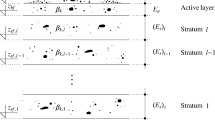Abstract
Alluvial rivers may experience intense sediment transport and rapid bed evolution under a high flow regime, for which traditional decoupled mathematical river models based on simplified conservation equations are not applicable. A two-dimensional coupled mathematical model is presented, which is generally applicable to the fluvial processes with either intense or weak sediment transport. The governing equations of the model comprise the complete shallow water hydrodynamic equations closed with Manning roughness for boundary resistance and empirical relationships for sediment exchange with the erodible bed. The second-order Total-Variation-Diminishing version of the Weighted-Average-Flux method, along with the HLLC approximate Riemann Solver, is adapted to solve the governing equations, which can properly resolve shock waves and contact discontinuities. The model is applied to the pilot study of the flooding due to a sudden outburst of a real glacial-lake.
Similar content being viewed by others
References
Zhang R J, Xie J H. Sedimentation Research in China—Systematic Selections. Beijing: China Water and Power Press, 1993
Zech Y, Spinewine B. Dam-break induced floods and sediment movement-state of the art and need for research. In: Proceedings of the First Workshop of EU Project IMPACT, HR Wallingford, 2002. 16–17
Cenderelli D A, Wohl E E. Flow hydraulics and geomorphic effects of glacial-lake outburst floods in the Mount Everest region, Nepal. Earth Surf Proc Landf, 2003, 28: 385–407
Cenderelli D A, Wohl E E. Peak discharge estimates of glacial-lake outburst floods and “normal” climatic floods in the mount Everest region, Nepal. Geomorphology, 2001, 40: 57–90
O’Connor J E, Baker V R. Magnitudes and implications of peak discharges from glacial lake Missoula. Geol Soc Am Bull, 1992, 104: 267–279
Baker V R, Benito G, Rudoy A N. Paleohydrology of late Pleistocene superflooding, Altai Mountains, Siberia. Science, 1993, 259(5093): 348–350
Liu S Z, Li H X, Yan Y, et al. Assessment of bursting hazards of the ice lakes in Luozha county, Tibet. J Mount Sci, 2003, 12(1): 128–132
Che T, Li X, Mool P K, et al. Monitoring glaciers and associated glacial lakes on the east slopes of mount Xixiabangma from remote sensing images. J Glaciol Geocryol, 2005, 12(6): 801–805
Liang L, Ni J R. Simulation of dike-break processes in the Yellow River. Sci China Ser E-Tech Sci, 2002, 45(6): 606–619
Zhang X Z, Wang G Q. Flow analysis and scour computation of the dike-break. J Sed Res, 2002, 1: 18–24
Zoppou C, Roberts S. Numerical solution of the two-dimensional unsteady dam break. Appl Math Model, 2000, 24: 457–475
Valianil A, Caleffi V, Zanni A. Case study: Malpasset dam-break simulation using a two-dimensional finite volume method. J Hydraul Eng, ASCE, 2002, 128: 460–472
Cao Z X, Pender G, Wallis S, et al. Computational dam-break hydraulics over erodible sediment bed. J Hydraul Eng, ASCE, 2004, 130: 689–703
Simpson G, Castelltort S. Coupled model of surface water flow, sediment transport and morphological evolution. Comput Geosci, 2006, 32: 1600–1614
Batchelor G. An Introduction to Fluid Dynamics. Cambridge: Cambridge University Press, 1967
Zyserman B J, Fredsoe J. Data analysis of bed concentration of suspended sediment. J Hydraul Eng, ASCE, 1994, 120(9): 1021–1042
Billett S J, Toro E F. On WAF-type schemes for multidimensional hyperbolic conservation laws. J Comput Phys, 1997, 130: 1–24
Toro E F. Shock-Capturing Methods for Free-Surface Shallow Flows. England: Wiley, 2001
Sleigh P A, Gaskell P H, Berzins M, et al. An unstructured finite-volume algorithm for predicting flow in rivers and estuaries. Comput Fluids, 1998, 27: 479–508
Hubbard M E, Dodd N. A 2D numerical model of wave run-up and overtopping. Coast Eng, 2002, 47: 1–26
Cao Z X, Yue Z Y, Li X, et al. Two-dimensional mathematical modeling of flooding over erodible sediment bed. In: Proc. 32nd IAHR Congress, Venice, Italy, 2007
Author information
Authors and Affiliations
Corresponding author
Additional information
Supported by the National Basic Research and Development Program of China (973 Program) (Grant No. 2007CB14106), the National Natural Science Foundation of China (Grant No. 50459001), and the Key Project of Chinese Academy of Sciences (Grant No. KZCX3-SW-357-02)
Rights and permissions
About this article
Cite this article
Yue, Z., Cao, Z., Li, X. et al. Two-dimensional coupled mathematical modeling of fluvial processes with intense sediment transport and rapid bed evolution. Sci. China Ser. G-Phys. Mech. Astron. 51, 1427–1438 (2008). https://doi.org/10.1007/s11433-008-0135-1
Received:
Accepted:
Published:
Issue Date:
DOI: https://doi.org/10.1007/s11433-008-0135-1




